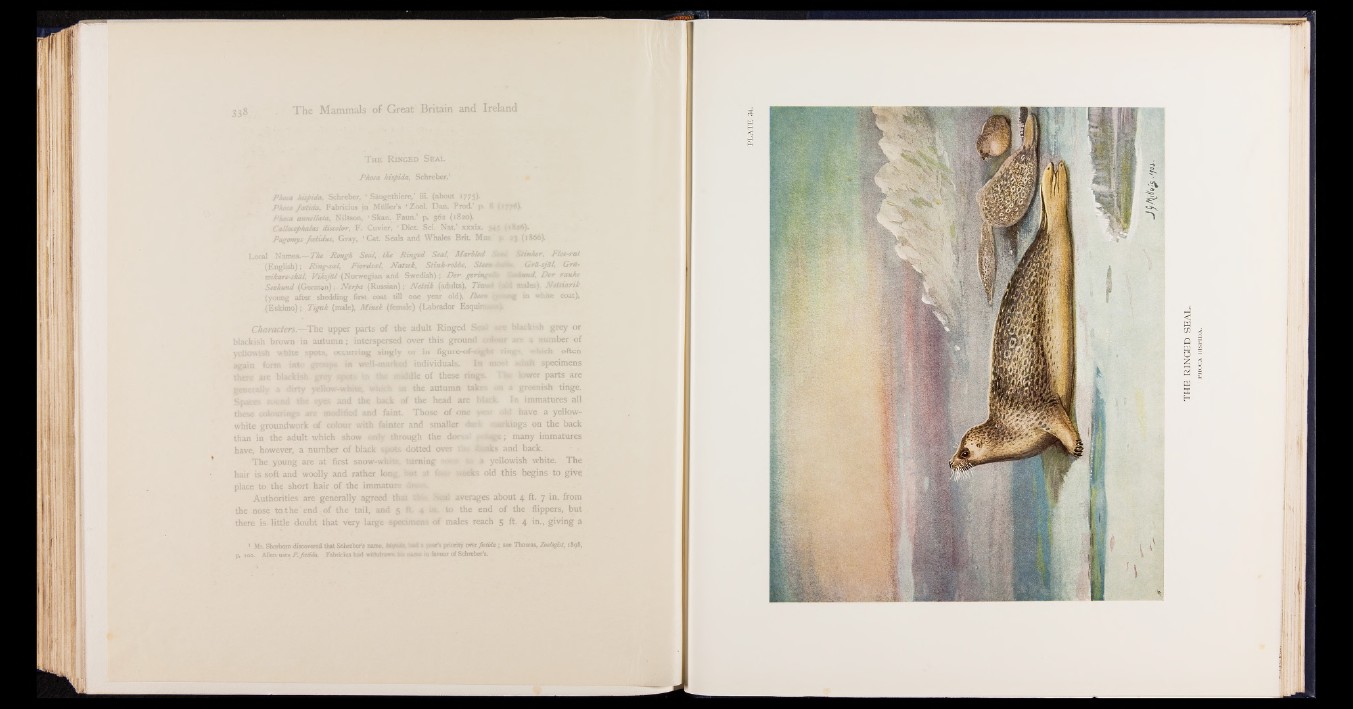
3 3 ? The Mammals of Great Britain and Ireland
T h e R in g e d S e a l
Pkoca hispida, Schreber.1
Pkoca hispida, Schreber, ‘ SSugethiere,’ iii. (about 1775).
Pkoca fcetida, Fabridus in Mllller's ‘ Zool Dan. Prod’ p. 8 (■ “ ;<>).
Pkoca annellata, Nilsson, ‘ Skah. Faun.* p. 362 (1820).
Callocephalus discolor, F. Cuvier, ‘ Diet. Sci. Nat.’ xxxix. 54? (1826).
Pagomys feetidus. Gray, ‘ Cat. Seals and Whales Brit. Mus p. 23 (1866).
Local Names.— The Rough Seal, the Ringed Seal, Marbled Smd, Stinker, Floe-rat
(English); Ring-sal, Fiordsal, Natsek, Stink-robbe, Steen m m ,. GrU-sjOl, GrU-
wikare-skul, Viksjd.1 (Norwegian and Swedish); D er germge&s vtkund, D er rauhe
Seekund (German); Nerpa (Russian) ; N etsik (adults), Tivmk vM males) N etdarik
(young after. shedding first. coat till one year old), /been • ■ c .ig in white coat),
(Eskimo); . Tigak (male), M insk (female) (Labrador Esqum ..,,- ;
Characters:— The upper parts of the adult Ringed Seal are blackish grey or
blackish brown in autumn; interspersed over this ground co4e«r are ? number of
yellowish white spots, occurring singly or in figure-of-eight rings which often
again form into groups in well-marked individuals. In meet aduft specimens
♦ here are blackish grey spots in Iht cmddle of these rings. I fee lower parts are
genet aUv a dirty yeUow-white, which in the autumn takes on a greenish tinge.
Spates ’ the eyes and the back of the head are black In immatures all
these colourings are modified and faint. Those of one y*i< M have a yellow-
white groundwork of colour with fainter and smaller dm ■ m kings on the back
than in the adult which show only through the dors* • -g e ; many immatures
-imks and back,
a yellowish white. The
•..-.xks old this begins to give.
have, howeyer, a number of black spots dotted over
The young are at first snow-white, turning
hair is soft and woolly and rather lone mt ■’
place to the short hair of the immature
Authorities are generally agreed that this Svm averages about 4 ft. 7 in. from
the nose to the end of the tail, and 5 ft- 4 in. to the end of the flippers, but
there is little doubt that very large sped men:-: of males reach 5 f t 4 in., giving a
1 Mr. Sherbom discovered that Schreber’? name, hispida, lad a year’s priority wit* fcetida ; see Thomas, Zoologist, 1898,
p, 102. Allen uses P . fcetida. Fabricius had withdrawn his name in favour of Schreberis.
m .